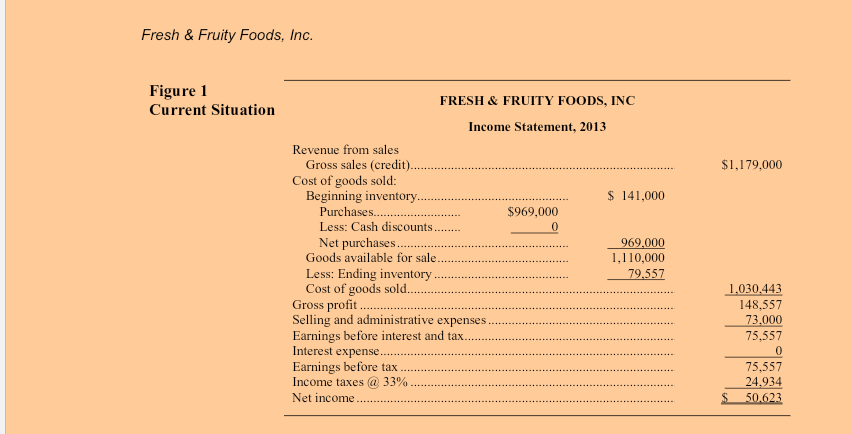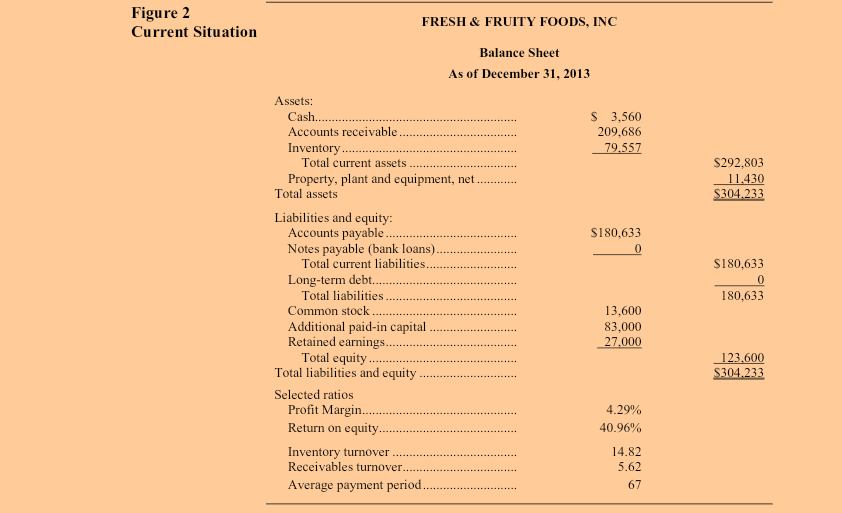Required 1. Using the data in Figures 1 and 2, compute the company’s average collection period (ACP) in days. Use a 360-day year when calculating sales per day. 2. Compute the cost, as a percent, that the company is paying for not taking the supplier’s discounts. (The supplier’s terms are 2/10, net 60; but note from the bottom of Figure 2 that Fresh & Fruity has been taking 67 days to pay its suppliers, making that the effective final due date for accounts payable.)
Fresh & Fruity Foods is a mail-order company operating out of a winery near Santa Rosa, California. The company specializes in sending California specialties to catalog customers nationwide. Sales are seasonal, with most occurring in November and December—when people select Fresh & Fruity’s Famous Fruit Fantasy boxes as Christmas gifts. Although seasonal, the company’s sales are fairly predictable, because the bulk of Fresh & Fruity customers are regulars who come back year after year. The company has also managed to smooth out its sales somewhat by offering incentives, such as the Fruit of the Month club, that encourage customers to buy throughout the year.
The nature of the mail-order business is such that most of Fresh & Fruity’s sales are on credit; therefore, the company has historically had a high
In January 2011, Tom Appleby and Alice Plummer, the president and treasurer of Fresh & Fruity, respectively, were discussing the cash flow problem over lunch.
“You know, Tom,” Alice said as she sliced a piece of avocado, “I was reading the other day about a company called Kringle’s Candles & Ornaments, and it occurred to me that we’re a lot like them. Most of our assets are current ones like their accounts receivable and inventory; and over half of ours are financed just like theirs, by current liabilities—that is, accounts payable.” She paused for a sip of chardonnay, and continued, “They got around their cash flow problems by issuing long-term debt, which took the pressure off their current obligations. I’ve been looking at that for our company, too; but then I got to thinking, there’s another way that’s a good deal easier and would produce results just as quickly.”
“Oh? What’s that?” Tom replied, his interest captured.
“All we have to do,” she said, “is to reduce our accounts receivable balance. That will help reduce our accounts payable balance—since, as our customers begin paying us earlier, we can pay our suppliers earlier in turn. If we could get enough customers to pay us right away, we could even pay some of the suppliers in time to take advantage of the 2 percent discount they offer for payments within 10 days.” (Fresh & Fruity’s suppliers operated on a 2/10, net 60 basis.) “That would increase our net income and free up even more cash to take advantage of even more discounts!” She looked excited at the prospect.
“Sounds great, but how do we get people to pay us earlier?” Tom inquired, doubtfully.
“Easy,” Alice continued. “Up to now we’ve been giving them incentives to pay later. Remember our ‘Buy Now, No Payments for Two Months’ program? Well, a lot of our customers use it, and it’s caused our accounts receivable balance to run way up. So what we have to do now is give them incentives to pay earlier. What I propose is to cancel the buy now/pay later plan and offer a 10 percent discount to everyone who pays with their order, instead.”
“But won’t that cause our revenues to drop?” Tom asked, again still doubtful.
“Yes, but the drop will be offset by even more new customers who will come in to take advantage of the discount. I figure the net effect on sales will be just about zero, but our accounts receivable balance could be cut in half! Now here’s a kicker that I just thought of: After we’ve reduced our accounts receivable balance as far as practical, I’d like to look into the possibility of reducing our accounts payable still further by replacing them with a bank loan. The effective rate of interest that we pay by not taking our suppliers’ discounts is, after all, pretty high. So what I’d like to do is take out a loan once a year of a sufficient size that would enable us to take all the discounts our suppliers offer. The interest that we’ll pay on the loan is bound to be less than what we pay in discounts lost—so we’ll see another gain in earnings on our income statement. In fact, these two initiatives together might have a really significant impact!”
“You’ve convinced me,” Tom said, “Let’s go back to the office and run some figures to see what happens!”
Financial statements for Fresh & Fruity Foods, Inc., are presented in Figure 1 (income statement) and Figure 2 (balance sheet).
Required
1. Using the data in Figures 1 and 2, compute the company’s average collection period (ACP) in days. Use a 360-day year when calculating sales per day.
2. Compute the cost, as a percent, that the company is paying for not taking the supplier’s discounts. (The supplier’s terms are 2/10, net 60; but note from the bottom of Figure 2 that Fresh & Fruity has been taking 67 days to pay its suppliers, making that the effective final due date for accounts payable.)


Trending now
This is a popular solution!
Step by step
Solved in 3 steps









